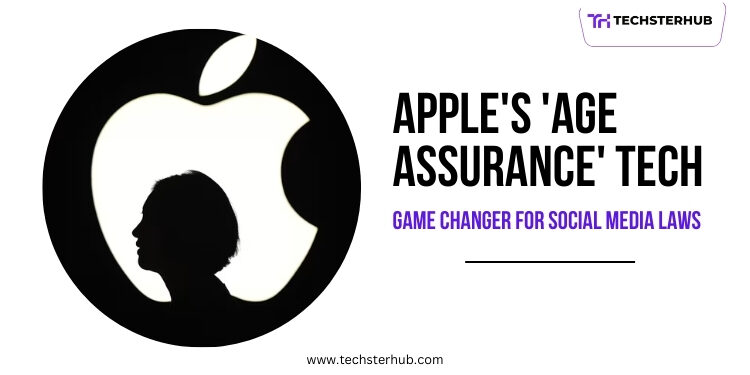Apple has introduced a new “age assurance” technology to keep young social media users safe from potential dangers. Multiple U.S. states are currently evaluating new legislative proposals to control social media platforms while protecting young users. This article examines Apple’s age assurance technology and its significance while explaining its connection to current U.S. debates about social media regulation.
What is Age Assurance Technology?
Apple’s New Technology: Age assurance technology enables companies such as Apple to verify user ages for their services and digital platforms. Apple uses this technology to protect young users from harmful or inappropriate content that could impact their development.
The system allows parents and guardians to manage the digital activities of their children more effectively. Apple can provide appropriate content like games and apps to children by verifying their age.
How It Works: Apple verifies the age of users both during account creation and when they attempt to access specific features on Apple devices through their age assurance technology. The system remains under development while its expected components include multiple methods.
- Self-Reporting: When registering for services or apps users must verify their age during the sign-up process.
- Third-Party Verification: Apple plans to implement third-party verification tools to enhance the accuracy of users’ age verification. To verify user ages these tools, require documents and facial recognition along with other data types.
- Parental Consent: Parents can monitor their child’s access to specific apps and content which depends on their age.
The method will prevent young people from using adult-oriented platforms or apps which may harm their mental health.
Why Does Age Assurance Technology Matter?
Growing Concern Over Social Media and Children: Young people integrate social media platforms such as Instagram, TikTok, and Snapchat into their daily lives. The platforms which entertain kids through creative interactions with their friends are now facing scrutiny for the negative effects they pose to young individuals. Parents and child safety experts identify cyberbullying along with online predators and harmful content as serious threats to children’s well-being.
The design of social media platforms aims to retain user engagement while young individuals face higher risks of excessive online activity. Young people face mental health problems alongside poor body image perceptions and reduced face-to-face social interactions when they spend excessive time on these platforms. Apple employs age assurance technology to reduce security risks by ensuring that only age-appropriate content reaches young users.
Legal Pressure and State-Level social media Laws: Alongside Apple’s program to protect young users, U.S. legislators are showing increased concern about how social media affects children. Some states have passed legislation to impose tougher controls on social media platforms’ interactions with minors while others contemplate similar measures.
Some state laws require social media platforms to secure parental consent before allowing underage users to create accounts. New legislation aims to control both the duration of minors’ social media usage and to regulate the specific content they can encounter online.
These laws aim to produce secure spaces for young users along with privacy protection measures. Legislators demand increased transparency from social media platforms while insisting they accept responsibility for their content management and interactions with minors.
Apple’s age assurance technology demonstrates strong compatibility with ongoing legal discussions. Apple’s implementation of these systems demonstrates its proactive stance in protecting minors while they use its devices and services. Apple’s age assurance technology demonstrates best practices which can motivate other tech companies to adopt similar measures to protect young users.
The Role of Parents in Protecting Their Children Online
Parental Control Features: Apple’s age assurance technology contributes to a wider trend that seeks to increase parental authority over their children’s online activities. Apple has long equipped parents with management tools for their children’s screen time and application restrictions.
This new technology from Apple will enable parents to achieve enhanced management capabilities regarding their children’s access permissions. Parents have the ability to track their children’s online behavior while they can also manage app downloads and establish screen time durations. Apple’s age assurance technology enables parents to prevent children from accidentally signing up for services or social media accounts they aren’t mature enough to access.
A Shared Responsibility: Tech firms like Apple need to build secure platforms but parents must also take active measures to safeguard their kids. Parents should educate their children about internet safety while promoting their use of digital resources in a responsible way. Apple’s age assurance technology serves as an integral component in discussions surrounding digital citizenship and personal responsibility.
What Does This Mean for the Future?
Potential Impact on Social Media and Tech Companies: The introduction of Apple’s age assurance technology could inspire other tech companies to implement similar systems. The implementation of this technology establishes a new standard for protecting young users online which may drive tech companies to change their approaches to user safety. Social media companies may have to implement age verification systems in response to potential new state regulations.
Social media platforms and apps must reconsider their data collection methods and interactions with minor users. The implementation of age verification systems might become standard practice across multiple digital services that interact with young users.
Challenges Ahead: Age assurance technology exists with good intentions yet faces multiple challenges which could hinder its wide-scale implementation. The utilization of personal and biometric data for age verification purposes creates potential privacy issues. Technical problems could occur as well as methods for users to evade age verification.
Many parents would find the amount of control that Apple has over their children’s online activities unsettling. It remains uncertain whether these precautions will suffice to defend young users against social media’s intricate challenges.
Conclusion:
Apple’s age verification technology represents a vital advancement for the protection of young people on internet platforms. Apple’s initiative functions as a prototype for tech companies while state-level discussions on social media laws continue. The implementation of these updates demonstrates how companies and legislators prioritize online child safety. The ongoing evolution of technology requires parents and tech companies along with lawmakers to collaborate in creating a safe and supportive digital environment for all users including young people.











